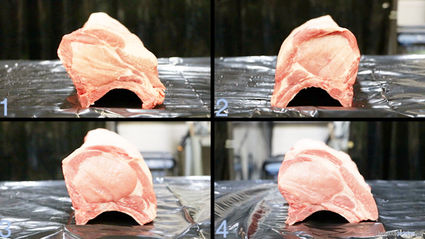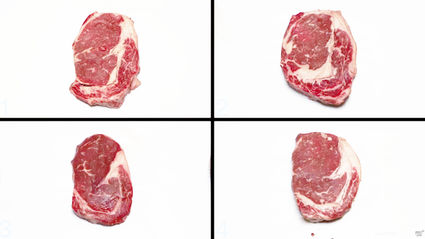Carcass Contest Results Are Reported and Winners Announced
September 2, 2020
When livestock is judged on the hoof at a county or state fair, the outward features are examined and conclusions drawn so that the livestock can be ranked and ribbons bestowed. However, that process differs drastically from judging a carcass on the rail. Livestock judges cannot see through the hide of an animal, so they must rely on their experience and knowledge to place the animals. Once the livestock is sent to slaughter and the hide is off, the beauty pageant is over and the science of a carcass contest can provide a true assessment.
After the 2020 Blaine County Fair, the animals of 4-H and FFA livestock exhibitors were judged against the strict standards and USDA grading criteria of the meat industry to reveal one Steer of Merit and eleven Swine of Excellence. There were no certified lamb rankings this year. The Steer of Merit top carcass winner for Market Beef is Seth Schroder, the Swine of Excellence top carcass winner for Market Swine is Drake Berreth, and the top carcass winner for Market Lamb is Henry Miller.
According to meat scientists, Montana Stockgrowers Association members, and Montana State University (MSU) Extension specialists who judge the carcasses, a carcass contest is an important learning tool in the livestock production process. It can give growers the real story on the quality of meat from the animals they raise since one main goal of participating in a livestock project is to produce a high quality product for the buyer/consumer. In fact, the carcass contest was developed for the benefit of 4-H and FFA members who use the carcass data to evaluate their breeding, feeding, and exercise programs.
"The carcass contest allows us to measure the hot carcass weight (HCW), the rib eye area (REA), and the backfat, as well as to determine the amount of marbling. The measurements taken in this contest offer a great indicator for members to see whether all their hard work and efforts really paid off in producing a quality meat product," Juli Snedigar, Blaine County MSU-Extension Agent said.
"To have an animal that meets these standards is a great achievement."
Schroder's Charolais/Angus steer bred by Schroder Ranch is an ideal case in point about the beauty pageant versus a final rail assessment since his 1415 pound live weight steer received a red ribbon on the hoof but was the only Blaine County Fair steer to win Steer of Merit (SOM) status.
To win SOM, Schroder's animal netted a HCW of 905 pounds. The HCW is the weight of the unchilled carcass after the head, hide and internal organs have been removed. That figure was used to determine a yield grade of 2.38 and a dressing percentage of 64%.
In calculating yield grade, the REA is also measured. Schroder's steer scored a 16.60 REA, which is the measure of the total area of the loin or ribeye between the 12th and 13th ribs.
Quality grading is based on maturity and marbling. In cattle that are fewer than thirty months old, the primary determinant of quality grade is the degree of marbling. Marbling, or intramuscular fat, is an estimate of the amount of fat present in the loin/ribeye muscle. Graders evaluate the amount of these fine threads of fat at the cut surface of the ribeye on the twelfth rib surface. As the meat cooks, this fat melts and essentially performs in two key ways: It keeps the meat tender and moist, while infusing the meat with flavor.
Another data point, backfat-which refers to the external fat thickness (in inches) measured at the twelfth rib, three quarters of the length of the ribeye from the spine-was .50 on Schroder's steer. This measure on a carcass is perhaps the most important determinant of retail yield. As fat thickness increases, cutability and percentage of retail product decrease, resulting in less desirable yield grades. According to industry standards, the optimum range for fat thickness is 0.25 to 0.60 inches.
Next, to claim top honors in the Swine of Excellence (SOE) carcass contest, Berreth's hog had an HCW of 168.54, a 64.33 dressing percentage, a .55 adjusted backfat score, and an 8.60 loin area measurement. With all other scores and calculations, Berreth's hog was 59.78% lean.
The other ten SOE winners were Morgan Friede, Kyra Berreth, Julian Powell, Jacob Metcalf, Ethan Klingaman, Hannah Richman, Kyle Hudon, Erik Pula, Gus Buck, and Katie Tilleman. Of the eleven hogs earning SOE status, three were bred by Hartland Colony and four were bred by Gruszie Show Pigs.
In the third species, sheep, none of the Blaine County animals made the final cut. Although his lamb didn't quite meet the industry standards for a Certified Lamb ranking, Miller's 149 pound live weight animal received a Choice Plus grade and a 60.3 final index after fat thickness, retail cuts, and ribeye measurements were taken.
Carcass contests like these not only provide competition, which is one important incentive for the improvement of any product, but bestow publicity and financial reward to those who achieve the desired status. These results will now go on to the state level, where Blaine County livestock will compete against animals from other fairs held across Montana.
Snedigar reported: "The youth did a great job of caring for their animals. We had the most finished animals this year that I have seen in several years. The average live weights for the three species were 1408 pounds for beef, 280 pounds for swine, and 140 pounds for lamb."




